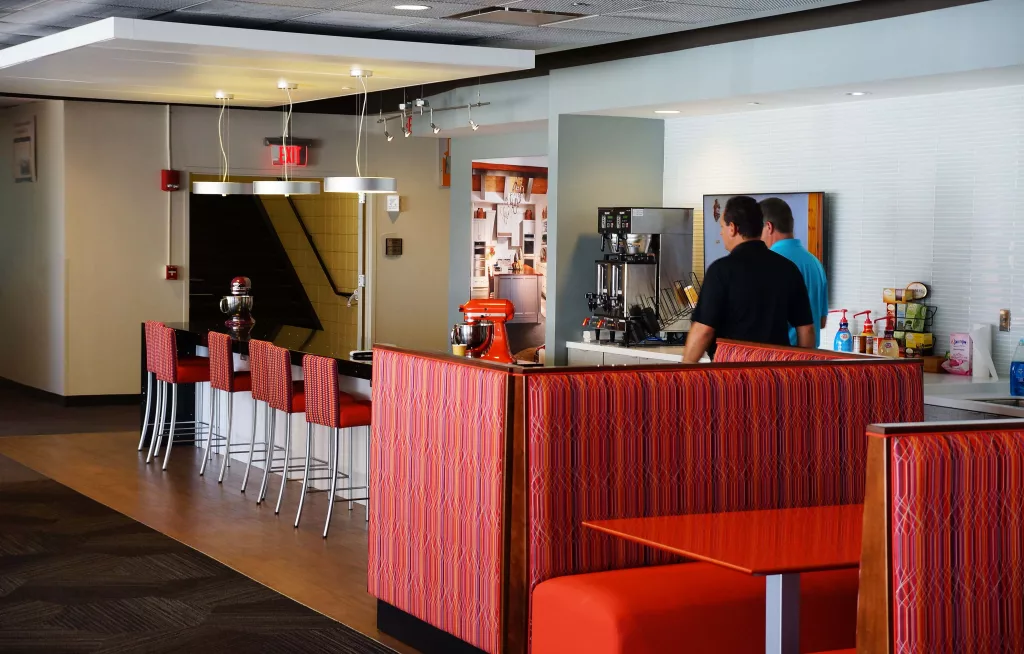In a simpler day and age, you could walk into virtually any major corporation and immediately tell where the key players sat even without an org chart or those little nameplates on the office doors. The power brokers always had the offices with big mahogany desks and a view to die for, if there was such a thing in the neighborhood where the headquarters building was situated.
Now, the power players have a pod and low profile walls similar in style to many others in the house, but they all have achieved remarkable sustainability with the materials, surfaces and environmental conditions that are equal on almost every plane. If you want a prime example of how that all plays out, take a look at the 7 to 8 year conversion of Whirlpool Global Headquarters north of St. Joseph and Benton Harbor along M-63.
The former top-down focus of the corner office and successively smaller units on down to the typing pool has become planned for and well-executed open space with collaboration centers and the ability to “meet” from desk to desk more streamlined than ever before.
Sure there was some grousing in the early stages, but the numbers don’t lie and employee surveys there now prove that 85-percent of the associates assigned to corporate headquarters feel more productive than ever before. It’s all the result of the goal to match the drive for product sustainability with the company’s own physical infrastructure sustainability.
When all was said and done, Whirlpool Corporation had been awarded a prestigious LEED Certification for not only global headquarters but their newly completed Riverview campus as well, both of which are in Benton Harbor.
The company’s Riverview Campus, the North American Region Headquarters, is now LEED Gold certified for Phase 3 of its development, and the Global Headquarters is LEED Silver certified for the South and East wings of the building.
LEED, or Leadership in Energy & Environmental Design, is a globally-recognized symbol of excellence in green building. These are the 14th and 15th LEED-certified projects for Whirlpool since 2009, with all projects now totaling more than 9.4 million square feet.
Lee Utke is Senior Director of Global Corporate Real Estate for Whirlpool, and he gave a quick media tour today to the Global Headquarters project completed in April of 2016. Utke says, “Being awarded additional LEED Certifications is validation of our long-held belief that sustainability is not just important for our business, but a responsibility on behalf of our consumers.” He points out, “Each project represents a continuation of our commitment to designing, constructing, and/or remodeling buildings using sustainable practices.”
With a focus on connectivity, shared innovation, and collaboration all designed to speed the time to market with new innovations in product design and performance, productivity is critical. With retention considerably cheaper and more efficient than recruitment, the productivity factor was a solid win and validates the strong new green approach.
Improved LED lighting, substantial new access to natural light, a substantially improved indoor air quality and access to outdoor air by providing outdoor access to wi-fi connections help employees to perform their work in a variety of settings.
Utke says the company’s sustainability index is also a key factor for prospective employees who want to work in conditions such as those and with investors interested in progressive companies focused on the future. Even the company’s new 1.1-million square foot manufacturing plant in Cleveland, Tennessee is LEED Gold certified.
Bicycle and walking paths on both campuses, a well-maintained Fisherman’s Park along the St. Joseph River at the Riverview Campus and other amenities like multiple kitchenettes (as shown in the photo accompanying this story on Moody on the Market.com) for lunch meetings and other sessions all add to the ability to connect at a moment’s notice. A dramatic improvement in the cafeteria at Global HQ in concert with a coffee bar and self-service vending station called Upton’s Corner for the founding fathers of the company also bring a quality of life to the employee base daily.
Electronic floor plans depicting ever office, “huddle station,” kitchenette or other meeting area give workers an immediate reading of which space is occupied and which spaces are available for impromptu sessions.
Developed by the U.S. Green Building Council (USGBC), LEED is the foremost program for buildings that are designed, constructed, maintained, and operated for improved environmental and human health performance.
In the Whirlpool projects, restroom faucets with ultra low-flow valves and toilets were designed to reduce water usage. When compared to the minimum baseline established by the Energy Policy Act of 1992, the fixtures’ performance results in an estimated 40-percent water savings for both facilities, approximately 1071-thousand gallons of water at the Riverview Campus, and approximately 697-thousand gallons at the Global Headquarters.
Energy efficiency was also a priority, with the Riverview Campus taking an integrated, whole campus approach. The facility was designed around a central plant heating and cooling system with a building management system, and incorporates high-efficiency interior and exterior lighting.
A waste-reduction plan was enacted during the construction process of all three phases for each building, resulting in thousands of tons of waste diverted from landfills at the Riverview Campus and Global Headquarters – 94-percent and 57-percent of total construction waste, respectively. At the Riverview Campus, materials containing recycled content constitute 31-percent of the total cost of materials, which included drywall, carpet in the office, steel columns, and concrete in the floor slabs and exterior site.
Both buildings maximize open space, with more than 111-thousand square feet of open space at the Riverview Campus, and nearly 284-thousand square feet of outside vegetated green space at the Global Headquarters. Open space helps reduce heat island effect, increases stormwater infiltration, and provides individuals on the site with a connection to the outdoors, a feature proven to increase employee productivity and satisfaction.
Both facilities promote alternative transportation methods to reduce the organization’s overall carbon footprint. Bike stations and bus routes are available to employees, as well as several electric car charging stations at each facility. Whirlpool Corporation has also set aside several dozen priority parking spots for low-emitting and fuel-efficient vehicles.
Whirlpool Corporation’s commitment to sustainability continues beyond the completion of construction. Their Riverview Campus will serve as an example of green building practices and as a tool to inform and educate consumers and other companies.
Whirlpool Corporation is the number one major appliance manufacturer in the world, with approximately $21 billion in annual sales, 93,000 employees and 70 manufacturing and technology research centers in 2016. The company markets Whirlpool, KitchenAid, Maytag, Consul, Brastemp, Amana, Bauknecht, Jenn-Air, Indesit and other major brand names in nearly every country throughout the world. Additional information about the company can be found at WhirlpoolCorp.com, or on Twitter at @WhirlpoolCorp.






